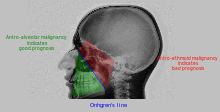Waters' view
Waters' view (also known as the Occipitomental view) is a radiographic view, where an X-ray beam is angled at 37° to the orbitomeatal line.[1] The rays pass from behind the head and are perpendicular to the radiographic plate. It is commonly used to get a better view of the maxillary sinuses. Another variation of the waters according to Merrill's Atlas of Radiographic Positioning and Procedures places the orbitomeatal line at a 37° angle to the image receptor.

Method of obtaining Waters' view
Structures observed
- Maxillary sinuses
- Frontal sinuses (oblique view)
- Ethmoidal cells
- Sphenoid sinus (through open mouth)
- Odontoid process (if it is just below the mentum, it confirms adequate extension of the head)
Possible observations
| Pathology | Observation |
|---|---|
| None (Normal) |
|
| Maxillary sinusitis |  Differentiating pathology in maxillary sinus
|
| Polyp |
|
| Malignancy |
 Onhgren's line
|
References
- Butler, Paul; Mitchell, Adam W. M. (Oct 28, 1999). Applied Radiological Anatomy. p. 97. ISBN 9780521481106.
Merrill's Atlas of Radiographic Positioning and Procedures vol 2 pg 328
This article is issued from
Wikipedia.
The text is licensed under Creative
Commons - Attribution - Sharealike.
Additional terms may apply for the media files.